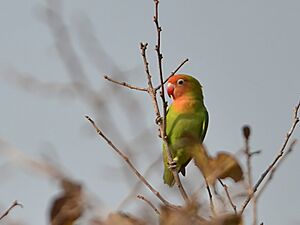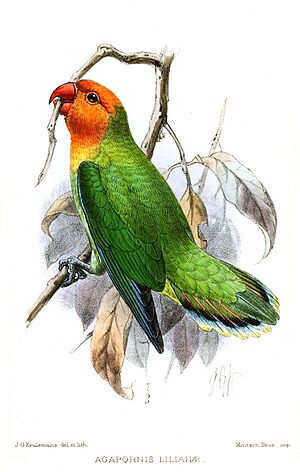Lilian's lovebird facts for kids
Quick facts for kids Lilian's lovebird |
|
|---|---|
 |
|
| Conservation status | |
| Scientific classification | |
| Genus: |
Agapornis
|
| Species: |
lilianae
|
 |
|
| Range in red. | |
Lilian's lovebird (Agapornis lilianae), also known as the Nyasa lovebird, is a small African parrot. It belongs to the group of birds called lovebirds. This bird is mostly green. It has bright orange feathers on its upper chest and head.
Lilian's lovebirds are about 13 centimeters (5 inches) long. This makes them the smallest parrot found on the mainland of Africa. It is not common to keep them as pets. They are also quite difficult to breed when they are not in the wild.
Contents
What Does the Lilian's Lovebird Look Like?
The Lilian's lovebird is a small bird. It is about 13 centimeters (5 inches) long. Most of its body is green. It has clear white rings around its eyes. The bird's head, neck, and upper chest are orange. Its lower back, called the rump, is green. Male and female Lilian's lovebirds look exactly alike.
People sometimes confuse Lilian's lovebirds with other types of lovebirds. The Fischer's lovebird is a bit bigger. It has an olive-green head and a blue rump. The rosy-faced lovebird also looks similar. However, its orange color is more distinct. It also does not have white rings around its eyes.
What Do Lilian's Lovebirds Eat?
Lilian's lovebirds eat many different things. They feed on seeds from grasses. They also enjoy millet and wild rice. Their diet includes various flowers. They also eat seeds and fruits from other plants.
Reproduction and Life Cycle
Lilian's lovebirds usually breed during two periods. These are from January to March and again in June and July. They build their nests inside tree cracks. They make a roof over their nest.
In places where they are cared for by humans, a female bird lays three to eight white eggs. The eggs hatch after about 22 days. The young birds, called chicks, leave the nest when they are about 44 days old.
Where Do Lilian's Lovebirds Live?
Lilian's lovebirds are found only in certain parts of Africa. These areas include Malawi, Mozambique, Tanzania, Zambia, and Zimbabwe. In 2004, experts thought there were fewer than 20,000 of these birds in the wild.
Today, most Lilian's lovebirds live in Liwonde National Park (LNP). Some smaller groups live in the forests around the park. Their homes are shrinking quickly. This is because their feeding and breeding areas are being used for farming. We do not know exactly how much habitat has been lost outside the park. However, the remaining forests are broken up into smaller pieces.
What Threats Do Lilian's Lovebirds Face?
Liwonde National Park is in southern Malawi. This area has many people living in it. About 100 to 115 people live in each square kilometer. Because of this, the park is greatly affected by more people and farming.
Recently, there have been more cases of Lilian's lovebirds being poisoned. It is not clear why this is happening. Researchers think that people might be trying to poison larger animals. The lovebirds then accidentally get poisoned instead.
How Long Do Lilian's Lovebirds Live?
Lilian's lovebirds usually live for 10 to 12 years. A big health concern for these birds is loneliness. These birds choose a partner for life. They need to be with their mate to stay healthy and happy.
Similarities to Other Birds
Lilian's lovebirds are closely related to rosy-faced lovebirds. Scientists have found this by studying their genes.
Lilian's Lovebirds in Human Care
Lilian's lovebirds are a challenging species to raise when they are in human care. Many bird breeders around the world find it hard to get these birds to breed successfully.



